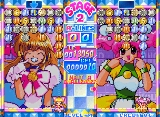
Money Idol Exchanger
Encyclopedia
Money Idol Exchanger is a puzzle game
created in 1997 by Japanese video game developer Face for the Neo Geo MVS
arcade
system. Athena Co. Ltd. ported it to the Game Boy
and the PlayStation
that same year. The Japanese PlayStation version was made available by MonkeyPaw Games on the Playstation Network's import store on November 16, 2010. http://www.joystiq.com/2010/11/16/money-idol-exchanger-and-sonic-wings-special-on-the-psn-import-s/
, Astro Pop, and Puzzle Bobble
series whereby players race to prevent a perpetually falling array of coins in different values from filling up the screen. Coins are combined (vertically and/or horizontally) to form higher valued coins; for example, five '1' coins will form a '5' coin, and two '5' coins will form a '10' coin, and so on, until two '500' coins are put together, at which point both disappear. Coins are arranged and colored to match denominations of the yen
coins. Two bonus tiles allow for changes in gameplay. A green RU tile will rank up all coins of the same denomination; for example, all '10' coins will become '50' coins. A blue ER title will erase all coins of the same value.
The game is won when any coin reaches the bottom of the opponent's screen.
In the single player mode, you control one of two characters who attempt to beat up to seven idiosyncratically named characters with names like Debtmiser, Mightdealer, Eldylabor, and Cherrybeiter. In the two player mode, both players fight each other until victory. The quicker and more efficiently each player clears out their screen, the quicker the other player's screen will fill up. Since filled screens offer the most opportunity for chaining together large combos, the tide can turn very quickly.
There is also another single player mode called Solo Mode. Any character can be played in this mode. The aim in Solo Mode is to continually clear the screen from coins and try to keep the game going for as long as possible.
Computer puzzle game
Puzzle video games are a genre of video games that emphasize puzzle solving. The types of puzzles to be solved can test many problem solving skills including logic, strategy, pattern recognition, sequence solving, and word completion....
created in 1997 by Japanese video game developer Face for the Neo Geo MVS
Neo Geo (console)
The is a cartridge-based arcade and home video game system released on July 1, 1991 by Japanese game company SNK. Being in the Fourth generation of Gaming, it was the first console in the former Neo Geo family, which only lived through the 1990s...
arcade
Arcade system board
An arcade system board is a dedicated computer system created for the purpose of running video arcade games. Arcade system boards typically consist of a main system board with any number of supporting boards...
system. Athena Co. Ltd. ported it to the Game Boy
Game Boy
The , is an 8-bit handheld video game device developed and manufactured by Nintendo. It was released in Japan on , in North America in , and in Europe on...
and the PlayStation
PlayStation
The is a 32-bit fifth-generation video game console first released by Sony Computer Entertainment in Japan on December 3, .The PlayStation was the first of the PlayStation series of consoles and handheld game devices. The PlayStation 2 was the console's successor in 2000...
that same year. The Japanese PlayStation version was made available by MonkeyPaw Games on the Playstation Network's import store on November 16, 2010. http://www.joystiq.com/2010/11/16/money-idol-exchanger-and-sonic-wings-special-on-the-psn-import-s/
Gameplay
Money Idol Exchanger is a stacking game similar to the Magical DropMagical Drop
, sometimes referred to by native Japanese users as , is a series of puzzle games originally released in the arcade, and later primarily released for several platforms such as the Neo Geo, Super Famicom, Sega Saturn and Neo Geo Pocket Color developed by Data East...
, Astro Pop, and Puzzle Bobble
Puzzle Bobble
, also known as Bust-a-Move, is a 1994 arcade puzzle game created by Taito Corporation, based on Taito's popular 1986 arcade game Bubble Bobble, featuring characters and themes from the original...
series whereby players race to prevent a perpetually falling array of coins in different values from filling up the screen. Coins are combined (vertically and/or horizontally) to form higher valued coins; for example, five '1' coins will form a '5' coin, and two '5' coins will form a '10' coin, and so on, until two '500' coins are put together, at which point both disappear. Coins are arranged and colored to match denominations of the yen
Japanese yen
The is the official currency of Japan. It is the third most traded currency in the foreign exchange market after the United States dollar and the euro. It is also widely used as a reserve currency after the U.S. dollar, the euro and the pound sterling...
coins. Two bonus tiles allow for changes in gameplay. A green RU tile will rank up all coins of the same denomination; for example, all '10' coins will become '50' coins. A blue ER title will erase all coins of the same value.
The game is won when any coin reaches the bottom of the opponent's screen.
In the single player mode, you control one of two characters who attempt to beat up to seven idiosyncratically named characters with names like Debtmiser, Mightdealer, Eldylabor, and Cherrybeiter. In the two player mode, both players fight each other until victory. The quicker and more efficiently each player clears out their screen, the quicker the other player's screen will fill up. Since filled screens offer the most opportunity for chaining together large combos, the tide can turn very quickly.
There is also another single player mode called Solo Mode. Any character can be played in this mode. The aim in Solo Mode is to continually clear the screen from coins and try to keep the game going for as long as possible.

